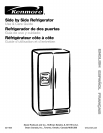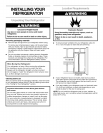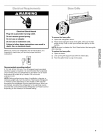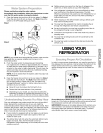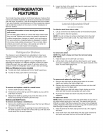
Please read before using the water system.
Immediately after installation, follow the steps below to make
sure that the water system is properly cleaned.
1. Open the freezer door and turn off the ice maker. For Style 1
lift up the wire shut-off arm as shown. For Style 2 move the
switch to the OFF (right) setting as shown.
Style I
Style 2
NOTE: If your model has a base grille filter system, make sure the
base grille filter is properly installed and the cap is in the
horizontal position.
2. Flush the water system by dispensing and discarding
2 to 3 gallons (8 to 12 liters) or approximately 6 to 7 minutes
of water after the water begins dispensing. It will take 3 to 4
minutes for the water to begin dispensing. This will clean the
system and help clear air from the lines. Additional flushing
may be required in some households.
NOTE: As air is cleared from the system, water may spurt out
of the dispenser.
3. Open the freezer door and turn on the ice maker. For Style 1
lower the wire shut-off arm. For Style 2 move the switch to
the ON (left) position. Please refer to the "ice Maker and
Storage Bin/Bucket" section for further instructions on the
operation of your ice maker.
• Allow 24 hours to produce the first batch of ice.
• Discard the first three batches of ice produced.
• Depending on your model, you may want to select the
maximum ice feature to increase the production of ice. To
do so, set the switch on the front of the ice maker to MAX.
I_ " )@s'_,_]i_=l_" ,I ,+ . ..... ,,= % • +
Your new refrigerator may make sounds that your old one didn't
make. Because the sounds are new to you, you might be
concerned about them. Most of the new sounds are normal. Hard
surfaces, like the floor, walls, and cabinets, can make the sounds
seem louder than they actually are. The following describes the
kinds of sounds and what may be making them.
• If your product is equipped with an ice maker, you will hear a
buzzing sound when the water valve opens to fill the ice
maker for each cycle.
• The defrost timer will click when the automatic defrost cycle
begins and ends. Also, the Thermostat Control (or
Refrigerator Control depending on the model) will click when
cycling on and off.
Rattling noises may come from the flow of refrigerant, the
water line, or items stored on top of the refrigerator.
Your refrigerator is designed to run more efficiently to keep
your food items at the desired temperature. The high
efficiency compressor may cause your new refrigerator to run
longer than your old one, and you may hear a pulsating or
high-pitched sound.
Water dripping on the defrost heater during a defrost cycle
may cause a sizzling sound.
You may hear the evaporator fan motor circulating the air
through the refrigerator and freezer compartments.
As each cycle ends, you may hear a gurgling sound due to
the refrigerant flowing in your refrigerator.
Contraction and expansion of the inside walls may cause a
popping noise.
You may hear air being forced over the condenser by the
condenser fan.
• You may hear water running into the drain pan during the
defrost cycle.
USING YOUR
REFRIGERATOR
"' , ' ..... ,: A" OIY_):IJII;IT}?'I
In order to ensure proper temperatures, you need to permit air to
flow between the two sections. Cold air enters the bottom of the
freezer section and moves up. It then enters the refrigerator
section through the top vent. Air then returns to the freezer as
shown.
./
I€ €
I
Do not block any of these vents with food such as soda, cereal,
bread, etc. If the vents are blocked, airflow will be prevented and
the temperature controls will not function properly.
IMPORTANT: Because air circulates between both sections, any
odors formed in one section will transfer to the other. You must
thoroughly clean both sections to eliminate odors. To prevent
odor transfer from food, wrap or cover foods tightly.



